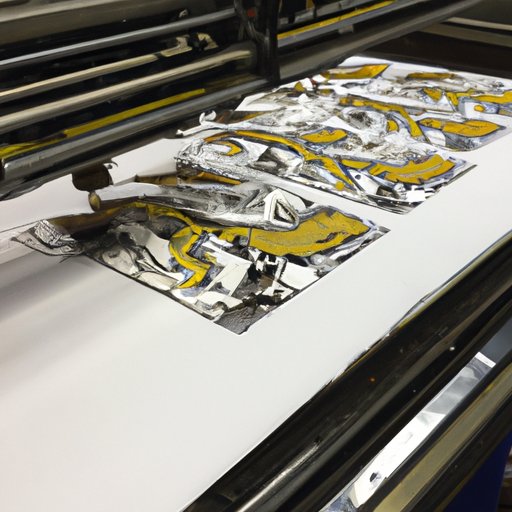Introduction
Screen printing is a popular form of printmaking that has been used for centuries to create prints on fabric. It involves pushing ink through a mesh screen onto fabric, paper or other materials. In this article, we’ll explore how does screen printing work and the different techniques and materials used in the process.
Explain the Process of Screen Printing Step-by-Step
The process of screen printing can be broken down into several steps: preparation, creating the screen, applying the ink, and transferring the design to the fabric.
Preparation
Before beginning the screen printing process, it’s important to prepare the materials you’ll be using. This includes gathering the necessary tools and supplies such as screens, inks, emulsions, and fabric. You’ll also need to prepare the fabric by washing and drying it, as any dirt or debris will affect the quality of the final print.
Creating the Screen
Once the materials are gathered, the next step is to create the screen. This is done by stretching a piece of mesh over a frame, usually made of wood or aluminum. The mesh is then coated with a photo-sensitive emulsion, which is exposed to light. This creates a stencil of your design, which allows the ink to pass through the mesh when it is applied.
Applying the Ink
Once the screen is prepared, it’s time to apply the ink. This is done by pressing the screen onto the fabric and pushing the ink through the mesh with a squeegee. Different types of inks are used for different fabrics, so it’s important to choose the right ink for the job.
Transferring the Design to the Fabric
Finally, the design is transferred to the fabric by pulling the screen away from the fabric. This process is repeated until the desired number of prints have been produced. Once the prints have dried, they can be ironed or heat-set to make them permanent.

Analyze the Benefits and Drawbacks of Screen Printing
Screen printing offers many advantages, including the ability to produce high-quality prints quickly and cost-effectively. It is also versatile, as it can be used to print on a variety of materials including fabric, paper, plastic, and metal. Additionally, screen printing is durable and long-lasting, as the ink is sealed into the fabric.
However, there are some drawbacks to screen printing. For example, it is a labor-intensive process, as each color requires a separate screen to be created. Additionally, it can be difficult to achieve intricate details with screen printing, as the mesh limits the level of detail that can be achieved.

Compare Screen Printing to Other Printmaking Techniques
Screen printing is often compared to other printmaking techniques, such as relief printing, intaglio printing, and lithography. Relief printing is a form of printmaking in which the design is carved or etched into a block of wood or linoleum. Intaglio printing is a form of printmaking in which the design is etched into a metal plate. Lithography is a form of printmaking in which the design is drawn on a stone or metal plate with a greasy substance.
Screen printing differs from these other techniques in that it is a direct printing process, meaning that the design is transferred directly from the screen onto the fabric. Additionally, screen printing is able to create large prints quickly and cost-effectively.
Outline Different Types of Screen Printing Inks
There are several different types of inks used in screen printing, each of which offers its own advantages and disadvantages. Plastisol ink is the most commonly used type of ink, as it is durable and produces vivid colors. Water-based ink is another popular choice, as it dries quickly and is easy to clean up. Eco-friendly ink is becoming increasingly popular, as it is non-toxic and biodegradable.
Profile Notable Screen Printers and Their Work
Screen printing has been used by many notable artists throughout history, including Andy Warhol, Shepard Fairey and Banksy. Warhol was a pioneer of the pop art movement and used screen printing to create his iconic prints of celebrities and everyday objects. Fairey is a contemporary artist who uses screen printing to create politically charged images. Banksy is a street artist who has used screen printing to create satirical works of art.
Describe How to Choose a Screen Printing Service Provider
When looking for a screen printing service provider, it’s important to do your research. Start by researching different providers, checking reviews, and asking for samples of their work. It’s also important to consider factors such as turnaround time, pricing, and customer service. Taking the time to find the right provider can help ensure that you get the best results.

Demonstrate How to Create a Screen Printing Design
Creating a screen printing design can seem daunting, but it doesn’t have to be. Start by choosing a design that you want to print. Then, prepare the design for screen printing by adjusting the size, formatting the image, and selecting the colors. Next, set up the screen by stretching the mesh and coating it with emulsion. Finally, print the design by pressing the screen onto the fabric and pushing the ink through the mesh.
Conclusion
In conclusion, screen printing is an effective and efficient way to create prints on fabric. It involves preparing the materials, creating the screen, applying the ink, and transferring the design to the fabric. It also offers many benefits, such as being versatile, durable, and cost-effective. Additionally, it can be used to create prints of any size or complexity. Screen printing has been used by many notable artists throughout history, and can be used to create eye-catching designs. By following the steps outlined in this article, you’ll be able to create beautiful prints with ease.
(Note: Is this article not meeting your expectations? Do you have knowledge or insights to share? Unlock new opportunities and expand your reach by joining our authors team. Click Registration to join us and share your expertise with our readers.)
